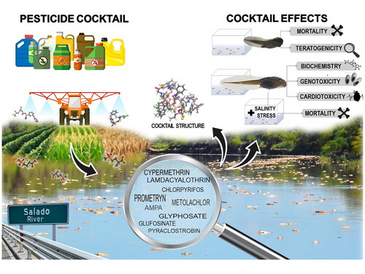A. P. C. Boccioni, R. C. Lajmanovich, A. M. Attademo, G. Lener, C. R. Lien-Medrano, M. F. Simoniello, M. R. Repetti and P. M. Peltzer
Drug and Chemical Toxicology, 1–19
Aquatic communities are increasingly exposed to complex mixtures of contaminants, mainly pesticides due to the impact of agricultural activity. The aim of this study was to evaluate the toxicity of an eight-pesticide cocktail on larvae of the South American common toad, Rinella arenarum. The cocktail represents a realistic mixture of insecticides (cypermethrin, chlorpyrifos and lambda-cyhalothrin), herbicides (glyphosate, glufosinate ammonium, prometryn and metolachlor), and a fungicide (pyraclostrobin) previously found in aquatic organisms (Prochilodus lineatus) from the Salado River Basin, an area with strong agricultural pressure. Computational simulations through the Density Functional Tight-Binding method indicated a strong spontaneous trend toward the formation of the cocktail, suggesting that it may act as a novel xenobiotic entity in the environment. The cocktail effects were evaluated in early-developing and premetamorphic larvae, at feasible concentrations found in real scenarios. The mixture led to high mortality and teratogenicity in early-developing larvae. Premetamorphic larvae showed endocrine disruption, oxidative stress, and impairments in detoxification and hepatic functioning. Neurotoxicity, genotoxicity, cardiotoxicity and high mortality under stress conditions were also observed in exposed larvae. This novel evaluation highlights the ecotoxicological risk for aquatic organisms exposed to complex mixtures and underscores the need to consider cocktail effects in studies regarding ecosystems health.

![[Translate to English:]](/fileadmin/user_upload/fachbereiche/fb1/lmcqm/logos/lmcqm-logo-3-padded-up-20.png)
